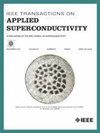Application of Flux-Coupling-Type SFCLs in a Power System Considering Fault Current Prediction Based on SAO-LSTM Model
IF 1.7
3区 物理与天体物理
Q3 ENGINEERING, ELECTRICAL & ELECTRONIC
引用次数: 0
Abstract
The improved flux-coupling-type superconducting fault current limiter (FC-SFCL) is a favorable option to fulfill the short-circuit current suppression in a power system, due to its fully-controlled features and two-level current-limiting modes. This paper explores the application of the FC-SFCLs in the power system, where the accurate fault current prediction is realized by the SAO-LSTM model. By integrating the snow ablation optimizer (SAO) and the long short-term memory (LSTM) network, the SAO-LSTM model is capable of extracting the fault current characteristics and reflecting the long-term historical process to forecast the fault current. Thus, the FC-SFCLs may select the appropriate current-limiting modes to handle the faults. The theoretical description of the FC-SFCL is conducted, and the fault current prediction method based on the SAO-LSTM model is expatiated. Using MATLAB, a modified IEEE 13-node system equipped with the FC-SFCLs is modeled. Different fault locations, fault types, and fault resistances are considered to build the dataset, and the prediction performance of the SAO-LSTM model for minor and severe faults is checked. The findings show that the SAO-LSTM model can effectively identify the severity of the faults, and the current-limiting efficiency of the FC-SFCLs under different fault severities and phase angles can be well exploited.考虑到基于 SAO-LSTM 模型的故障电流预测,通量耦合型 SFCL 在电力系统中的应用
改进型磁通耦合型超导故障电流限制器(FC-SFCL)具有完全可控的特性和两级限流模式,是实现电力系统短路电流抑制的有利选择。本文探讨了 FC-SFCL 在电力系统中的应用,其中 SAO-LSTM 模型实现了精确的故障电流预测。通过整合雪融优化器(SAO)和长短期记忆(LSTM)网络,SAO-LSTM 模型能够提取故障电流特征并反映长期历史过程,从而预测故障电流。因此,FC-SFCL 可以选择适当的限流模式来处理故障。本文对 FC-SFCL 进行了理论描述,并阐述了基于 SAO-LSTM 模型的故障电流预测方法。使用 MATLAB 对配备 FC-SFCL 的改进型 IEEE 13 节点系统进行了建模。在建立数据集时考虑了不同的故障位置、故障类型和故障电阻,并检验了 SAO-LSTM 模型对轻微故障和严重故障的预测性能。结果表明,SAO-LSTM 模型能有效识别故障的严重程度,并能很好地利用 FC-SFCL 在不同故障严重程度和相位角下的限流效率。
本文章由计算机程序翻译,如有差异,请以英文原文为准。
求助全文
约1分钟内获得全文
求助全文
来源期刊

IEEE Transactions on Applied Superconductivity
工程技术-工程:电子与电气
CiteScore
3.50
自引率
33.30%
发文量
650
审稿时长
2.3 months
期刊介绍:
IEEE Transactions on Applied Superconductivity (TAS) contains articles on the applications of superconductivity and other relevant technology. Electronic applications include analog and digital circuits employing thin films and active devices such as Josephson junctions. Large scale applications include magnets for power applications such as motors and generators, for magnetic resonance, for accelerators, and cable applications such as power transmission.
 求助内容:
求助内容: 应助结果提醒方式:
应助结果提醒方式:


